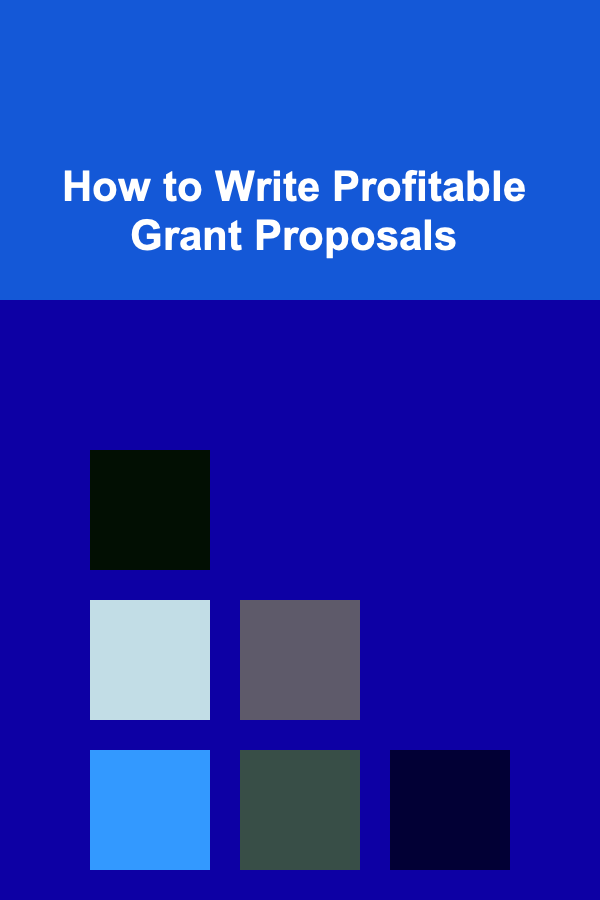
How to Write Profitable Grant Proposals
ebook include PDF & Audio bundle (Micro Guide)
$12.99$6.99
Limited Time Offer! Order within the next:

Writing a profitable grant proposal is a skill that can significantly impact the success of an organization or an individual seeking funding. Whether you are a non-profit, a researcher, or an entrepreneur, securing grants can provide the financial support necessary to turn ideas into reality. In this article, we will explore the critical steps in writing an effective and persuasive grant proposal that stands out from the competition.
Introduction to Grant Proposals
A grant proposal is a formal request for financial support from a government agency, foundation, or private organization. The proposal outlines the project or initiative for which funding is being sought, detailing how the money will be used, the anticipated outcomes, and how the project aligns with the funder's priorities.
The Importance of a Grant Proposal
Grant proposals are essential because they serve as the primary means of securing financial resources. They are not just a request for funds but an opportunity to showcase your project's potential, your organization's capability, and the broader impact you intend to make. An effectively written proposal can not only increase your chances of receiving funding but also establish long-term relationships with funders.
Step 1: Understand the Funder's Mission and Priorities
Before diving into the writing process, it is crucial to thoroughly understand the funder's mission and priorities. Each funding organization has specific goals and criteria, and aligning your project with these objectives is the first step in writing a successful proposal.
Research the Funder
Start by gathering as much information as possible about the funding organization. Visit their website, read through their mission statement, and review their past grant recipients. Most funders will provide guidelines on the types of projects they are willing to fund, their application process, and any specific criteria they use for decision-making. Pay attention to:
- Funding priorities: What areas or fields do they focus on? (e.g., education, healthcare, environment)
- Funding history: What types of projects have they funded in the past?
- Eligibility requirements: Who is eligible to apply for their grants?
- Application guidelines: What are the submission requirements (length, format, etc.)?
By understanding the funder's priorities, you can tailor your proposal to highlight how your project aligns with their goals.
Build a Relationship
Grant writing is not just about asking for money; it's about building a relationship. Engage with the funding organization before submitting your proposal. Attend informational webinars or events, and if possible, reach out directly to ask questions or get feedback on your project idea. Building this rapport can give you valuable insights into what the funder is looking for in a proposal.
Step 2: Craft a Compelling Proposal Narrative
The proposal narrative is the heart of the grant application. It tells the story of your project, explaining why it is important, how it will be executed, and the expected outcomes. A compelling narrative should be clear, concise, and well-organized.
Executive Summary
The executive summary is the first section of your proposal, but it is often written last. This section provides a brief overview of the entire proposal, summarizing your project's goals, methods, and expected outcomes. It should be concise---typically no more than one or two pages---and should highlight the most important aspects of your project. A strong executive summary will grab the funder's attention and encourage them to read the rest of the proposal.
Key elements of the executive summary include:
- Project title and brief description
- Goals and objectives
- Target population or beneficiaries
- Key activities
- Expected outcomes or impact
- Budget summary
Problem Statement or Need Assessment
The problem statement explains the issue your project seeks to address. It should provide clear evidence of the need for your project and demonstrate the urgency or significance of the problem. Funders want to know that the issue is well-researched and that there is a genuine need for intervention.
To write a strong problem statement:
- Use data and statistics to support your claims.
- Provide real-world examples or case studies that highlight the problem.
- Clearly define the scope and severity of the issue.
- Explain the consequences of not addressing the problem.
The problem statement should make a compelling case for why the funder should invest in your project.
Project Goals and Objectives
The goals and objectives section outlines what your project aims to achieve. Goals are broad, overarching statements of your project's purpose, while objectives are specific, measurable outcomes that contribute to achieving the goals.
- Goals: Focus on the long-term impact of your project.
- Objectives: Should be SMART---Specific, Measurable, Achievable, Relevant, and Time-bound.
Each objective should have a clear, direct link to the problem you are addressing, and each should be achievable within the project's timeframe and with the resources you have available.
Methodology or Project Plan
This section outlines how you will achieve the goals and objectives set out in your proposal. The methodology should be detailed and show that you have a clear plan for implementation. Funders want to know that your project is feasible and that you have the expertise to carry it out.
Key components to include in your project plan are:
- Timeline: A detailed timeline that outlines major milestones and activities.
- Activities: A step-by-step breakdown of what will be done and when.
- Roles and responsibilities: Who will be responsible for each task or activity? If possible, provide brief bios of key team members.
- Evaluation: How will you measure the success of your project? Define the metrics or indicators that will be used to assess progress.
Expected Outcomes and Impact
This section should explain the tangible results your project will deliver and the broader impact it will have. Funders want to know that their investment will lead to measurable, positive change.
- Outcomes: Should be specific and measurable. For example, "100 students will receive tutoring support" or "The rate of literacy in the community will increase by 20%."
- Impact: The long-term effects of your project on the target population or community. This could include systemic changes, policy reforms, or improvements in quality of life.
Ensure that your expected outcomes and impact are aligned with the funder's priorities and mission.
Step 3: Develop a Realistic Budget
A well-crafted budget is crucial to the success of your proposal. The budget outlines how the requested funds will be used and provides funders with a transparent view of how resources will be allocated. A realistic and well-detailed budget increases the credibility of your proposal and demonstrates that you can manage the funds responsibly.
Create a Detailed Budget
The budget should be broken down into categories such as:
- Personnel costs: Salaries or wages for staff working on the project.
- Materials and supplies: Costs of any materials or equipment needed for the project.
- Travel expenses: If travel is required for the project, include transportation, accommodation, and per diem costs.
- Consultants and subcontractors: Fees for any external experts or services.
- Overhead costs: General administrative costs, including office space and utilities.
Be sure to justify each expense, providing enough detail to show how each cost contributes to achieving the project's goals.
Avoid Over- or Under-Estimating Costs
Be realistic about the costs associated with your project. Overestimating costs may make you seem unprepared, while underestimating them may raise concerns about the feasibility of the project. Ensure that your budget reflects the actual costs of running your project and that you can justify every line item.
Include Matching Funds or In-kind Contributions (if applicable)
Some funders prefer to see a commitment of matching funds or in-kind contributions from your organization or other stakeholders. This shows that others believe in the project and are willing to invest in it.
Step 4: Edit and Proofread
Once you have written your proposal, take the time to thoroughly review and revise it. A well-edited proposal is crucial to making a professional impression. Pay attention to the following:
- Clarity and coherence: Ensure that your proposal is easy to read and that each section flows logically from one to the next.
- Grammar and spelling: Typos and errors can detract from the professionalism of your proposal. Use tools like Grammarly or ask someone else to proofread it.
- Formatting: Follow the funder's guidelines for formatting, including font size, margins, and submission methods.
- Consistency: Ensure that all your claims and data are consistent throughout the proposal.
Step 5: Submit the Proposal
Once your proposal is polished and ready, it's time to submit it. Before submitting, double-check that you have followed all the application guidelines and that you have included all required documents.
- Submission method: Whether the proposal is submitted via email, online portal, or postal mail, ensure that you follow the correct procedure.
- Deadline: Submit the proposal well in advance of the deadline to avoid any last-minute issues.
- Confirmation: Some funders provide confirmation of receipt. If this is the case, ensure that you receive confirmation and follow up if necessary.
Conclusion
Writing a profitable grant proposal is a comprehensive process that requires careful planning, research, and attention to detail. By understanding the funder's priorities, crafting a compelling proposal narrative, creating a realistic budget, and ensuring a professional submission, you can increase your chances of securing funding. A well-written grant proposal not only helps secure financial support but also builds the foundation for long-term relationships with funders that can lead to further opportunities in the future.
Reading More From Our Other Websites
- [Trail Running Tip 101] From Solo to Duo: Turning Your Solo Trail Runs Into Fun Friend Challenges
- [Home Pet Care 101] How to Socialize Your Puppy or Kitten Effectively
- [Home Rental Property 101] How to Handle Tenant Complaints Professionally and Efficiently
- [Home Soundproofing 101] How to Soundproof a Home Using Green and Sustainable Materials
- [Organization Tip 101] How to Archive Past Volunteer Projects for Reference
- [Small Business 101] How to Build a Zero‑Waste Supply Chain for a Boutique Coffee Roastery
- [Whitewater Rafting Tip 101] Best Whitewater Rafting Expeditions: Exploring Remote & Uncharted Rivers
- [Paragliding Tip 101] The Ultimate Paragliding Travel Packing List: Essentials for Every Pilot
- [Simple Life Tip 101] Best Budget‑Friendly Hobbies That Promote a Calm, Simple Life
- [Personal Investment 101] How to Use an Investment Calculator to Forecast Your Financial Future and Set Realistic Goals

How to Build and Sell AI Models for Long-Term Profit
Read More
How to Create a Study Zone for Students
Read More
How to Organize Utensils for Different Cooking Styles
Read More
How to Plan a Sustainable and Eco-Friendly Home Celebration
Read More
How to Use Seasonal Decor to Enhance Your Home's Appeal
Read More
How to Organize a Successful Political Campaign Rally
Read MoreOther Products

How to Build and Sell AI Models for Long-Term Profit
Read More
How to Create a Study Zone for Students
Read More
How to Organize Utensils for Different Cooking Styles
Read More
How to Plan a Sustainable and Eco-Friendly Home Celebration
Read More
How to Use Seasonal Decor to Enhance Your Home's Appeal
Read More